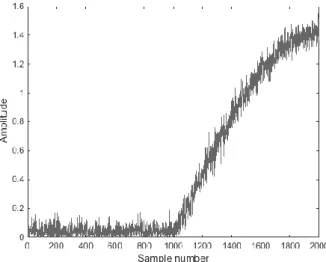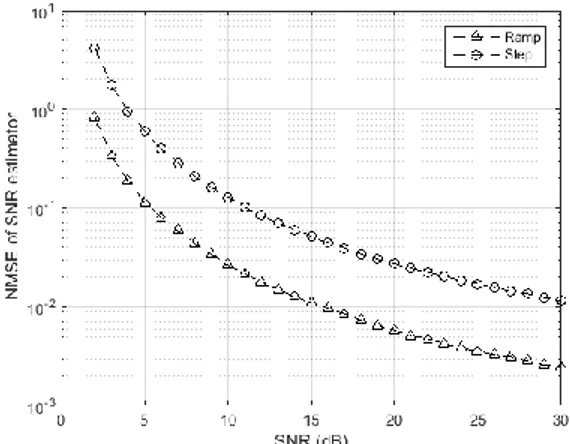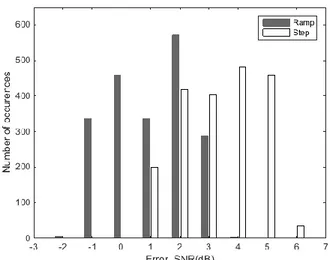© 2015 Ankara University SIGNAL-TO-NOISE RATIO ESTIMATION OF NOISY TRANSIENT SIGNALS
MEMDUH KÖSE 1, SELÇUK TAġCIOĞLU 2, ZĠYA TELATAR 2 1 Ahi Evran Univ, Computer Sciences Research and Application Center Kırşehir, Turkey
2
Ankara Univ, Faculty of Engineering, Electrical and Electronics Engineering Department Ankara, Turkey
E-mail: memduh.kose@ahievran.edu.tr, {selcuk.tascioglu, ziya.telatar}@eng.ankara.edu.tr
ABSTRACT
In this paper, the problem of signal-to-noise ratio (SNR) estimation of noisy transient signals is considered. The SNR estimation is performed based on the average energy of the transient and noise signals. The performance of the SNR estimator is evaluated in terms of normalized mean square error and normalized bias. It is shown by simulations that the SNR estimation method exhibits good estimation performance for the SNRs encountered in many practical applications. Besides, the effect of the estimation of the transient starting point on the performance of the SNR estimation is investigated
KEYWORDS: SNR estimation, transient signal detection, normalized bias, normalized mean square error
1. INTRODUCTION
The knowledge of signal-to-noise ratio enhances the performance of various wireless communication systems, which motivates the development of efficient SNR estimation techniques. Channel quality is measured using SNR estimation for many operations in wireless communication systems such as data rate adaptation, mobile assisted handoff, power control, and decoding. In wireless OFDM systems, various methods have been proposed for providing power and bandwidth efficiency by adapting the transmission parameters with respect to channel conditions in terms of SNR. For example, estimates of SNR were obtained for this purpose by utilizing the periodic structure of the OFDM preamble in [1]. Balachandran et al. proposed an adaptation method, which switches between the different modulation schemes depending on the SNR, in order to improve data throughput over fading channels [2]. In cognitive radio networks, SNR has been used as one of the parameters which can be employed by secondary users when sensing the
Commun.Fac.Sci.Univ.Ank.Series A2-A3 Volume 57, Number 1, Pages 11-19 (2015)
DOI: 10.1501/commua1-2_0000000084 ISSN 1303-6009
12 MEMDUH KÖSE, SELÇUK TAġCIOĞLU, ZĠYA TELATAR
spectrum occupancy for the aim of opportunistic access to unused frequency bands allocated to primary users [3]. SNR is also required for iterative decoding algorithms. Summers and Wilson addressed the effect of SNR estimation error on the performance of iterative turbo code decoder [4]. In [5], SNR was estimated based on Kalman filter to monitor the link quality in wireless sensor networks.
The SNR estimation approaches can be considered in two categories: data-aided and non data-aided. Wiesel et al. addressed both data-aided and non data-aided SNR estimators for phase-shift keying communication systems in time-varying fading channels [6]. A maximum likelihood based non-data aided algorithm was proposed for the SNR estimation purposes in the presence of constant deterministic interference [7]. For the applications where the bandwidth efficiency is an important parameter, non data-aided estimators may be preferred since throughput is reduced for data-aided estimators by inserting known symbols into the data stream [8]. For a detailed comparison of several SNR estimation methods for the additive white Gaussian noise channel, see [9].
When a wireless transceiver starts to transmit, carrier signal shows a transient behavior [10]. Transient signals are generated at the beginning of transmission and convey some characteristic information identifying the transceiver due to hardware imperfections of physical layer components. Transient signal analysis has been employed for many signal processing and communication applications. For example, in [10]-[11] some distinctive features based on detected transients have been extracted to classify the wireless devices. It was reported that increased accuracy of the transient signal detector increases the ability to obtain whole characteristic information [10].
SNR estimate of transient signals was employed to improve the performance of a wireless device identification system for noisy channels in [11]. This method was based on injection of noise into the neural network training set. The amount of noise to be added to the training set was determined by the SNR estimate of test transient. Thus, SNR estimation accuracy of an unknown transient has become an important issue for device identification systems based on transient analysis. In this paper, we investigate a non data-aided SNR estimation technique for noisy transients based on average energy ratio of transient and noise signals as well as the effect of transient detection on the performance of the SNR estimation.
2. SNR ESTIMATION BASED ON AVERAGE ENERGY The discrete time transient signal at the receiver can be given as
SIGNAL-TO-NOISE RATIO ESTIMATION 13
( ) ( ) ( )
y k s k n k (1)
where
s k
( )
andn k
( )
denotes transient and noise signals, respectively. Let average energy of noisy transient be2 1 1 K SN k E y k K (2)
where K represents the analysis window length. By using the fact that the noise is independent of the signal, Eq. (2) can be written in terms of signal and noise terms as
2 2 1 1 1 K 1 K SN k k E s k n k K K (3)
since the statistical average of
s k n k
( ) ( )
equals to zero for the independent case [12]. The SNR for transient signal is defined as the ratio of the average energy of the transient signal to the average energy of noise signal. The SNR estimation in dB is calculated as10
ˆ 10log SN 1
N
E
E (4)
where
E
N stand for the average energy of the noise segment.E
N can be calculated during no transmission. This approach has been used for SNR estimation of wireless communication signals [11] as well as of speech signals [13]. In [13], SNR estimation was performed using the noise power obtained from the non-speech segments which were detected by using different voice activity detectors. In the same work, the effect of these detectors on the performance of the SNR estimation methods were investigated.3. TRANSIENT SIGNAL DETECTION
Detection of transients for wireless devices is a difficult problem, since this task requires estimating the starting point of noise-like behavior transient signals. One of the methods for transient detection is to formulate the problem as a change-point detection problem [14]-[15]. In [15], a method based on a ramp signal model was proposed to detect the starting point of transients in a Bayesian framework. The performance of this method was compared to a previous approach in [14], which was based on a piecewise constant signal
14 MEMDUH KÖSE, SELÇUK TAġCIOĞLU, ZĠYA TELATAR
model containing a step change. It was experimentally verified that the transient detection performance of the ramp detector is better than that of the abrupt change detector for turn-on transients of Wi-Fi transmitters. It was also reported that the method can also be used for the transient detection of the Bluetooth devices. In this paper, we employ both of these Bayesian approaches to detect noise corrupted transients at different SNR levels.
4. PERFORMANCE METRICS
Mean Square Error (MSE) is a widely used metric to evaluate the performance of the SNR estimator since the variance and bias of the estimator are both included in the MSE [7]-[9]. MSE of the SNR estimator is defined as
2 1 1 ˆ T ˆt t MSE T (5)
where T denotes the number of independent Monte Carlo trials. In Eq. (5) the error terms can be normalized with respect to true SNR in which case the quantity is called normalized MSE (NMSE) and given by
2 1
ˆ
1
ˆ
T t tNMSE
T
(6)NMSE demonstrates the asymptotic behavior of the estimator as the SNR increases [9]. The results are also given in terms of normalized bias which is defined as
1 ˆ 1 ˆ T t t t NB T (7) 5. SIMULATION RESULTS
IEEE 802.11b standard defines the transmit power-on ramp by a smoothly increasing function in order to avoid adjacent channel interference [16]. Considering this definition, transient signals were simulated using four different signal models: the rising parts of the cosine, raised cosine, Gaussian and exponential functions. These functions are shown in Figure 1. The start of the transient was chosen to be sample 1000 following channel noise with a length of 1000 samples. Therefore total analysis signal window was consisted of 2000 samples. Simulated Gaussian noise was added to transient signal and the SNR level
SIGNAL-TO-NOISE RATIO ESTIMATION 15
of the detected noisy transient was estimated. 500 Monte Carlo simulations were performed for each signal model.
Figure 1. Simulated transient signals based on four different models
Figure 2. Simulated noisy transient signal generated from the rising part of the cosine at the SNR value of 25 dB
16 MEMDUH KÖSE, SELÇUK TAġCIOĞLU, ZĠYA TELATAR
Normalized bias and normalized MSE of the SNR estimator are plotted in Figure 3 and Figure 4, respectively. In these figures, estimated SNR values are given for the transients which are detected by using two different transient detection methods. Figure 3 shows that the SNR estimator is biased and overestimates SNR for both cases. Also, it is observed from this figure that as the SNR increases, normalized bias values decreases. When the transient is detected using Bayesian ramp detector, normalized bias of the SNR estimator is small and does not change significantly as
Figure 3. Normalized bias of the SNR estimator
SIGNAL-TO-NOISE RATIO ESTIMATION 17
the SNR changes. On the other hand for the Bayesian step detector, the bias of the SNR estimator increases as the SNR decreases. Figure 4 demonstrates that the normalized MSE of the SNR estimator decreases with increasing SNR for both cases.
The effect of transient detection accuracy on the performance of the SNR estimator can be observed from Figure 3 and Figure 4. When the transient is detected using ramp detector, a better SNR estimation performance is achieved over the entire range of SNR values. The performance improvement of the ramp detector increases with decreasing SNR. It is evident from these two figures that the SNR estimator in Eq. (4) can be used for SNR estimation with a reasonable error as long as the transient detection is performed accurately.
It was reported in [11] that the SNR of the transient signals is expected to vary in the range of 10-15 dB for many practical applications. It is evident from Figure 4 and Figure 5 that the estimation performance is good for these SNR values as the transients are detected by using a ramp detector. The histograms of SNR estimation error are given in Figure 5 for two transient detection methods at the actual SNR level of 10 dB. The mean values of SNR estimation error were found to be 1.0 dB and 3.3 dB for ramp and step detectors, respectively. These results are consistent with the results in Figure 3.
Figure 5. Error histogram of the SNR estimator at the actual SNR of 10 dB for two different transient detection method
18 MEMDUH KÖSE, SELÇUK TAġCIOĞLU, ZĠYA TELATAR 6. CONCLUSIONS
In this paper, SNR estimation of noisy transient signals is investigated. In order to evaluate the estimation performance, normalized MSE and normalized bias metrics are defined. Simulation results show that the performance of the SNR estimator is good for the SNRs encountered in many practical applications. In addition, the SNR estimator can be used with a reasonable error for lower SNR levels from 2 dB to 10 dB as long as the transient detection performance is high.
ÖZET: Bu makalede gürültülü geçici rejim iĢaretlerinin sinyal-gürültü oranı kestirimi problemi ele alınmaktadır. SNR kestirimi, geçici rejim ve gürültü sinyallerinin ortalama enerji değerlerine dayalı olarak hesaplanmaktadır. SNR kestirici baĢarımı, düzgelenmiĢ hata kareleri ortalaması ve düzgelenmiĢ yanlılık değerleri üzerinden değerlendirilmektedir. Ġncelenen kestiricinin çoğu pratik uygulamada karĢılaĢılan SNR değerleri için iyi baĢarıma sahip olduğu benzetim sonuçlarıyla gösterilmektedir. Ayrıca, geçici rejim sinyali baĢlangıç noktası kestiriminin SNR kestirim baĢarımı üzerindeki etkisi de incelenmektedir.
REFERENCES
[1] M. Zivkovic and R. Mathar, Preamble-based SNR estimation in frequency selective channels for wireless OFDM systems, In Proceeding of IEEE Vehicular Technology Conference, (2009), p.1-5.
[2] K. Balachandran, S. R. Kadaba, S. Nanda, Channel quality estimation and rate adaptation for cellular mobile radio, vol. 17, (1999), p.1244-1256.
[3] J. Vartiainen, H. Saarnisaari, J.J. Lehtomaki, M. Juntti, A Blind Signal Localization and SNR Estimation Method, In Proc. IEEE Military Communications Conference (MILCOM), (2006), p.1-7.
[4] T.A. Summers and S.G. Wilson, SNR mismatch and online estimation in turbo decoding, IEEE Transactions on Communications, vol. 46, (1998), p.421-423.
[5] F. Qin, X. Dai, J.E. Mitchell, Effective-SNR estimation for wireless sensor network using Kalman filter, Ad Hoc Networks, vol. 11, (2013), p.944-958.
SIGNAL-TO-NOISE RATIO ESTIMATION 19
[6] A. Wiesel, J. Goldberg, H. Messer-Yaron, SNR estimation in time-varying fading channels, IEEE Transactions on Communications, vol. 54, (2006), p.841-848.
[7] F. Chen, Y. Kang, H. Yu, F. Ji, Non-data-aided ML SNR estimation for AWGN channels with deterministic interference, EURASIP Journal on Wireless Communications and Networking, (2014).
[8] C. Gong, B. Zhang, A. Liu, D. Guo, A Highly accurate and low bias SNR estimator: Algorithm and implementation , Radioengineering, Proceedings of Czech and Slovak Technical Universities and URSI Committees, vol. 20, (2011), p.976-981.
[9] D.R. Pauluzzi and N.C. Beaulieu, A comparison of SNR estimation techniques for the AWGN channel, IEEE Transactions on Communications, vol. 48, (2000), p.1681-1691. [10] O. Ureten and N. Serinken, Wireless security through RF fingerprinting, Canadian Journal of Electrical and Computer Engineering, vol. 32, (2007), p.27-33.
[11] O.H. Tekbas, O. Ureten, N. Serinken, Improvement of transmitter identification system for low SNR transients, Electronics Letters, vol. 40, (2004), p.182-183.
[12] A.B. Carlson and P.B. Crilly, Communication Systems: An Introduction to Signals and Noise in Electrical Communication (McGraw –Hill, New York, 2010) p.924.
[13] M. Vondrasek and P. Pollak, Methods for speech SNR estimation: Evaluation tool and analysis of VAD dependency, Radioengineering, Proceedings of Czech and Slovak Technical Universities and URSI Committees, vol. 14, (2005), p.6-11.
[14] O. Ureten and N. Serinken, Detection of radio transmitter turn-on transients, Electronics Letters, vol. 35, (1999), p.1996-1997.
[15] O. Ureten and N. Serinken, Bayesian detection of Wi-Fi transmitter RF fingerprints, Electronics Letters, vol. 41, (2005), p.373-374.
[16] IEEE Std 802.11b-1999, Part 11, Wireless LAN medium access control (MAC) and physical layer (PHY) specifications: Higher-speed physical layer extension in the 2.4 GHz band, (IEEE Inc., New York, 1999), p.90.


